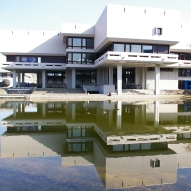| Dokumentenart: | Artikel | ||||
|---|---|---|---|---|---|
| Titel eines Journals oder einer Zeitschrift: | OncoImmunology | ||||
| Verlag: | TAYLOR & FRANCIS INC | ||||
| Ort der Veröffentlichung: | PHILADELPHIA | ||||
| Band: | 5 | ||||
| Nummer des Zeitschriftenheftes oder des Kapitels: | 12 | ||||
| Seitenbereich: | e1242543 | ||||
| Datum: | 2016 | ||||
| Institutionen: | Medizin > Lehrstuhl für Chirurgie Medizin > Lehrstuhl für Pathologie Medizin > Zentren des Universitätsklinikums Regensburg > Regensburger Centrum für Interventionelle Immunologie (RCI) | ||||
| Identifikationsnummer: |
| ||||
| Stichwörter / Keywords: | COLITIS-ASSOCIATED TUMORIGENESIS; IMMUNE CELLS; EXPRESSION; MARKERS; INFLAMMATION; PROGRESSION; 1ST-LINE; GROWTH; KI-67; PCNA; Peritoneal carcinomatosis; proliferation; senescence; tumor milieu; T(H)1; T(H)17 | ||||
| Dewey-Dezimal-Klassifikation: | 600 Technik, Medizin, angewandte Wissenschaften > 610 Medizin | ||||
| Status: | Veröffentlicht | ||||
| Begutachtet: | Ja, diese Version wurde begutachtet | ||||
| An der Universität Regensburg entstanden: | Ja | ||||
| Dokumenten-ID: | 42016 |
 Web of Science
Web of ScienceZusammenfassung
Background: Peritoneal carcinomatosis (PC) is a terminal evolution from primary colorectal cancer (pCRC) associated with poor patient survival. Impact of the immune cell infiltrate on PC pathogenesis is unknown. Therefore, we characterized the immunological tumor microenvironment regarding proliferation, senescence and neovascularization. Methods: Formalin-fixed and paraffin-embedded (FFPE) ...

Zusammenfassung
Background: Peritoneal carcinomatosis (PC) is a terminal evolution from primary colorectal cancer (pCRC) associated with poor patient survival. Impact of the immune cell infiltrate on PC pathogenesis is unknown. Therefore, we characterized the immunological tumor microenvironment regarding proliferation, senescence and neovascularization. Methods: Formalin-fixed and paraffin-embedded (FFPE) tissue of PC and pCRC was examined by immunohistochemistry. Cells infiltrating resected tissue were isolated and analyzed by flow cytometry. PCR arrays detected the expression of genes relevant for helper T (T-H) cell responses, like T(H)1, T(H)2 and T(H)17 response. Results: PC tumor cells demonstrate significantly lower proliferation rates than pCRC, but show significantly more senescence. PC is surrounded by significantly increased numbers of cytotoxic active Natural Killer (NK) cells, follicular helper T cells (T-FH) and B cells, whereas pCRC shows more CD4(+) T-H cells, CD8(+) cytotoxic T (T-C) cells, eosinophilic granulocytes, T(H)17 and regulatory T (T-reg) cells. PC is characterized by significantly increased interferon-gamma (IFN gamma), an upregulation of tumor necrosis factor (TNF) and the NK cell-regulating cytokine interleukin-15 (IL-15). An upregulation of angiogenesis-related genes, like vascular endothelial growth factor-A (VEGF-A), leads to severe neovascularization in PC. Correlations of PC results reveal that elevated numbers of interleukin-17 (IL-17) positive cells are associated with high cancer cell proliferation, whereas high numbers of IFN gamma positive cells correlate with more tumor cells in senescence. Conclusion: The cellular immune reaction is modified during metastasis, inducing senescence in PC tumor cells. Immune surveillance in PC is facilitated by NK cells and high levels of IFN gamma and TNF. Counteracting this effect, T-FH and B cells combined with VEGF-A enhancement promote neovascularization in PC (Illustration 1). [GRAPHICS] During metastasis from primary CRC to PC the immune cell infiltrate changes, accompanied by the induction of senescence in PC cancer cells (marked red): In pCRC, the antitumor immune response is facilitated by CD4(+)T(H) cells, CD8(+)T(C) cells and PRG2(+) eosinophilic granulocytes. The premetastatic niche development is promoted by T-reg cells and T(H)17 cells producing systemic factors like VEGF-A, TGF-beta and TNF. Along with T-FH and B cells, as with a pro-tumor immune response, they support metastatic formation and lead to severe neovascularization in PC. This is counterbalanced by the IL-15-induced activation and proliferation of NK cells. The secreted cytokines IFN gamma and TNF mediate immunosurveillance.
Metadaten zuletzt geändert: 17 Mrz 2020 11:04



 Altmetric
Altmetric